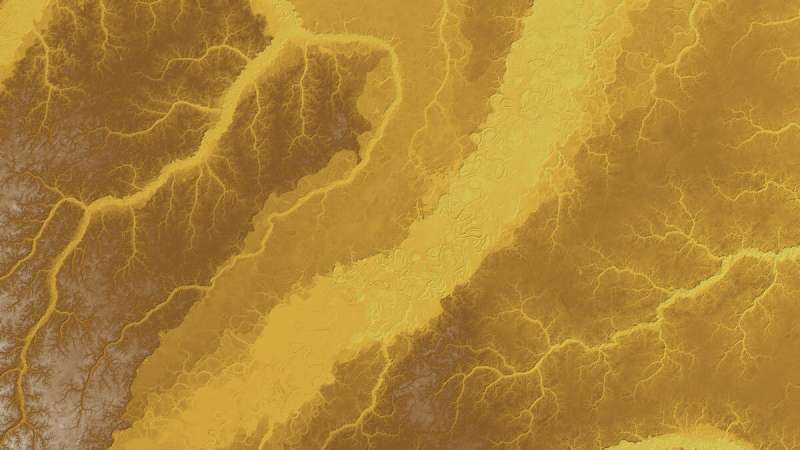How climate change shaped the Amazon's land and life

The Amazon basin is one of the most biodiverse places on the planet; its nearly 8 million square kilometers (3 million square miles) may be home to as many as 10 percent of the world's species. Under the Amazon's renowned tree canopy, the meandering Amazon River system—the largest in the world, with the highest discharge—is important to the region's biodiversity and shapes its landscape.
Generally, rivers can be thought of as either eroding their channels or building them up, and the amount of sediment they carry can define which of those two states they are in. If a river is carrying lots of sediment without much water, it will deposit the sediment and build up its floodplain. Alternatively, if a river is gushing without much sediment, it will cut into its banks and bed, carving a valley and abandoning terraces above the riverbed.
In the case of the Amazon River system, it features a patchwork of deep channels and wide sediment terraces that can rise tens of meters above the water, forming disconnected islands floating between rivers. The system's patchwork landscape could be a result of rivers' surprisingly nimble responses to swings in climate during the last ice age, according to a new study by Goldberg et al. When the climate shifted during this time period, it could have caused the rivers to erode, then change to start building up their floodplains. The results of this new study could help explain not only the Amazon's landscape but also its biodiversity and could upend assumptions about how the Amazon was built.
Building up, then tearing down
For many large rivers, reshaping a river channel after a switch from erosion to deposition is a slow process, taking hundreds of thousands of years. Because of that, large rivers are typically thought to respond too slowly to reflect rapid changes in climate, such as swings between glacial and interglacial periods.
The authors challenge the idea that the Amazon is too big to change. To test their hypothesis, the researchers combined modeling river flows and sediment load with topographic analyses, examining how landscapes could evolve in response to a changing climate. To their surprise, they found the Amazon could have switched from eroding to building in tens of thousands of years, which is easily quick enough to reflect climate changes, said Samuel Goldberg, a geomorphologist from the Massachusetts Institute of Technology who led the study.
"We found that the Amazon's average response timescale is only a few tens of thousands of years, which is substantially shorter than the 100,000-year period of glacial cycles," said Goldberg.
Their result marks a fundamental change in scientists' understanding of landscape evolution in the Amazon and potentially for other large rivers.
"The landscape is recording these big oscillations in climate, which we didn't really consider would have happened with the Amazon River. There was an assumption that big rivers like this were resilient to rapid changes in climate," said José Constantine, a geomorphologist at Williams College who was not involved in the study.
The pattern of distinct landforms created by rivers and climate oscillations could have contributed to habitat fragmentation. Steep, deep river channels can act as barriers for certain species. Over time, those barriers can lead to isolation and new evolutionary pathways.
"There were physical changes [to] the landscape where these habitats are shifting, growing, shrinking, connecting," said Goldberg. Those shifts could have created more niches for plants and animals to fill and in which they could evolve.
"We live on a planet that is incredibly sensitive to climatic and tectonic changes and even the changes we impose on it directly. And those changes have consequences," said Constantine. "This study highlights the potential role that climate oscillations could have played in evolution and in long term habitat development."
More information: Samuel L. Goldberg et al, Fast Response of Amazon Rivers to Quaternary Climate Cycles, Journal of Geophysical Research: Earth Surface (2021). DOI: 10.1029/2021JF006416
Provided by Eos
This story is republished courtesy of AGU Blogs (https://eos.org/), a community of Earth and space science blogs, hosted by the American Geophysical Union. Read the original story here.



















